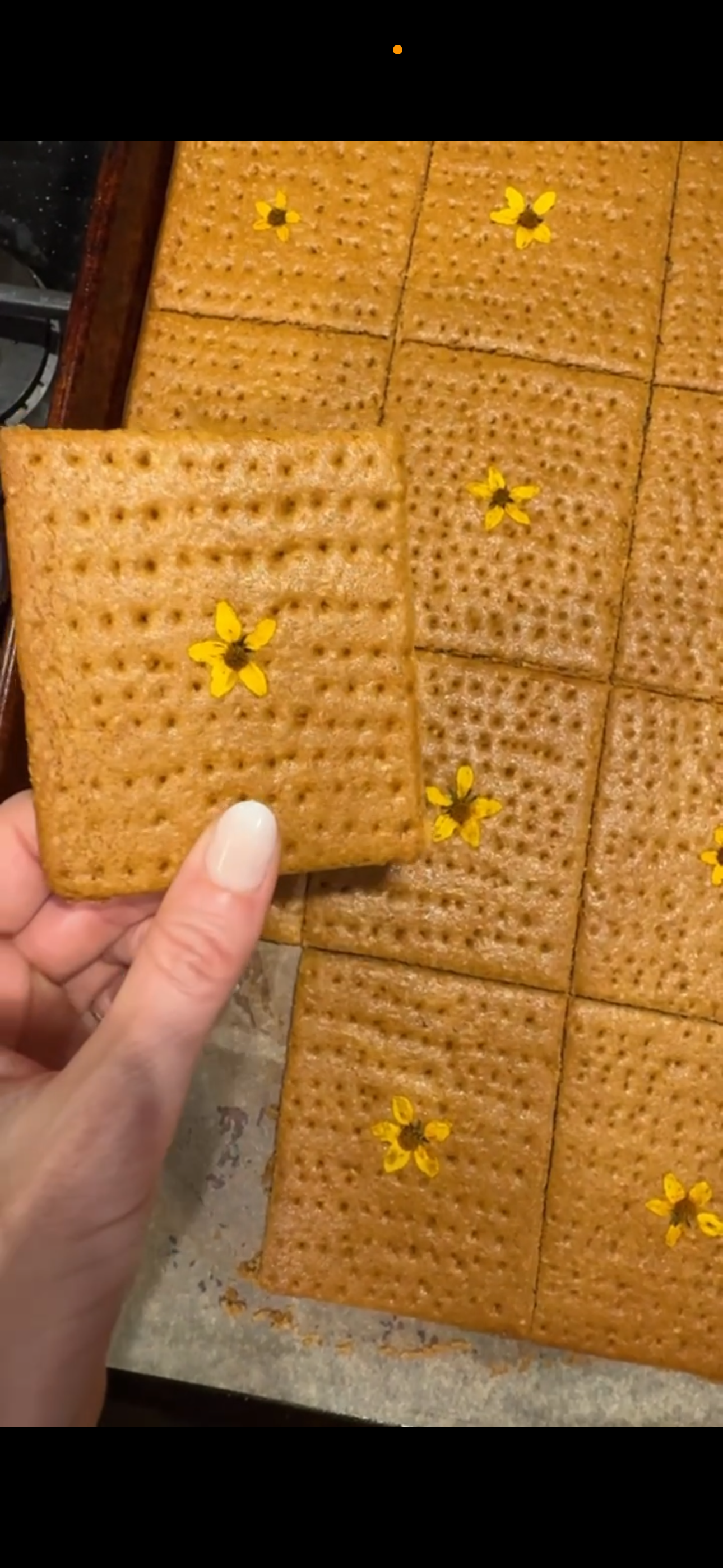Graham Crackers (sourdough discard)
Sourdough Graham Crackers
A Naturally Nostalgic Treat with a Botanical Twist
There’s something deeply comforting about the sweet, toasty flavor of a graham cracker. It evokes childhood snacks, campfire s’mores, and cozy afternoons. But what if you could take that nostalgic flavor and elevate it—using your sourdough discard, whole grain flours, and perhaps even a botanical accent like cinnamon, basil or pressed edible flowers? This is my take on the humble graham cracker: sustainable, fragrant, and beautifully rustic. Next recipe? Of course marshmallows, stay tuned…
A Brief (and Surprisingly Radical) History of the Graham Cracker
Graham crackers have a curious origin story rooted not in indulgence—but in restraint.
They were invented in the early 19th century by Sylvester Graham, a Presbyterian minister and early health reformer who believed in a vegetarian diet free from sugar, white flour, and excess. His followers, known as “Grahamites,” adhered to what he called a “clean” lifestyle: no meat, no alcohol, no refined grains, and certainly no indulgence of the senses.
Graham developed his namesake cracker as a bland, coarse, unsweetened biscuit made from whole-wheat flour—intended to suppress appetite (and allegedly, impure thoughts). His original cracker was a far cry from today’s honey-kissed commercial version, but it laid the foundation for a uniquely American food with Puritanical roots.
Over time, graham crackers evolved. Honey and molasses were added. Later, cinnamon and sugar. Eventually, they became the sweet pantry staple we know today.
Why Sourdough Discard?
I love honoring culinary traditions—but I also love reinventing them. Using sourdough discard in graham crackers not only reduces kitchen waste, it adds a lovely tang and complexity to the dough. The sourdough enriches the whole grain flavors and creates a tender snap that’s perfect for snacking, layering in desserts, or crumbling into pie crusts. It’s a way to make something deeply familiar feel entirely new.
Recipe
MAKES: makes 2 sheets of graham crackers (up to you how many squares you cut)
INGREDIENTS:
1 cup whole wheat flour (150 g)
1 cup all-purpose flour (140 g)
1/3 cup wheat germ (40 g)
1 teaspoon baking soda
½ teaspoon salt (3 g)
8 tablespoons salted butter, softened (113 g)
1 cup light brown sugar (200 g)
¼ cup honey (84 g)
1 teaspoon vanilla extract (4 g)
½ cup sourdough discard (142 g)
a handful of edible flowers- I used yellow biden blooms here
INSTRUCTIONS:
In a mixing bowl, whisk together the whole wheat flour, all-purpose flour, wheat germ, baking soda, and salt. Set aside.
In the bowl of a stand mixer fitted with the paddle attachment, cream the softened butter, brown sugar, and honey until pale and fluffy.
Mix in the vanilla extract and sourdough discard just until incorporated.
Add the dry ingredients to the wet mixture and stir until a cohesive dough forms.
Shape the dough into a flat disk, wrap in plastic wrap, and refrigerate for at least 2 hours (up to 72 hours if preferred).
Fold a large sheet of parchment paper in half and place half of the dough between the layers. Roll it out into a rectangle about 1/8 inch thick. This recipe requires you to roll out twice as it bakes 2 whole sheet trays, so roll out the remaining dough the same way.
Gently peel off the top layer of parchment, cut into your preferred cracker shapes, and pierce each one with a fork. You can also press edible flowers or herbs into the dough for a cute decoration.
Using a flexible mat under the parchment paper, transfer the rolled dough (with the bottom parchment still attached) onto a baking sheet. Remove the flexible mat.
Bake in a preheated oven at 365°F for 15–20 minutes, or until the edges are golden. Baking times may vary depending on your oven and dough thickness, so keep a close eye on them.
Allow crackers to cool completely, they should be crisp. If they are not, you can put them back in the oven to dry them out. I would do so at 300°F for about 10 minutes, or until they are all golden brown and crisp.
Notes
Don’t skip the chilling—it's key to handling the dough easily and helps develop that flaky texture.
Dough can be refrigerated up to 72 hours for a deeper sourdough flavor.
Roll the dough as evenly as possible. Uneven thickness may cause some areas to overbake or underbake.
These bake quickly due to their thinness, so watch closely toward the end of the baking time.
Like all baked goods, they will continue baking after you remove them from the oven.


